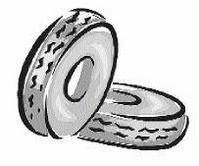
Checking the pressure is a healthy habit to develop. Very often, drivers overlook this very important aspect of safety. A vehicle with a poorly inflated tyre may cause the vehicle to vibrate.
"Check the pressure first," says Basil Smith, proprietor of Singer B's Tyre Sales and Service Centre, St Andrew. "Deviation in pressure from one tyre to another can cause shimmy ... so, too, can low tyre pressure."
Tyres that are not inflated to manufacturer's specification will wear out faster than properly inflated tyres. Underinflated tyres wear away more rapidly on the shoulders than in the centre. In addition to vibration and rapid wear, low pressure may cause tyre squeal on turns, hard steering, bruised tyres, broken tyre cords, decreased fuel economy and damage to the tyre by wheel-rim impact.
Overinflated tyre
Overinflated tyres wear out faster in the centre than on the shoulders. Also, if pressure is higher than it should be, the vehicle rides harsher. Overinflated tyres also bruise easily, and traction at the rear wheels may be reduced. To keep tabs on tyre pressure, it is wise to purchase a tyre-pressure gauge. "Check inflation when the tyres are cold," says Smith.
Cold tyres are defined by the US's Rubber Manufacturers Association as those that have been stationary for at least three hours.
It is best to examine each tyre on the outside, inside and tread area for a bulge. If you can raise the car, so much the better. If not, get under the vehicle with a flashlight and ensure that no bulge exists.
A bulge indicates serious damage and a tyre that will blow out. Do not drive the car before replacing the tyre.
- Paul Messam